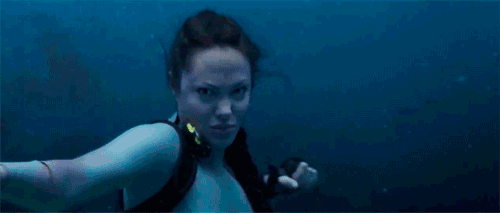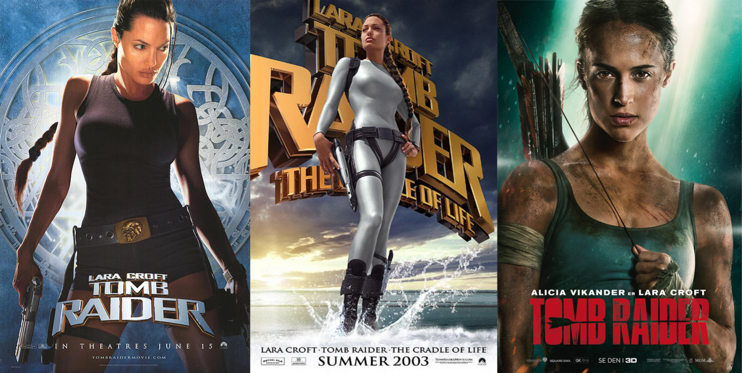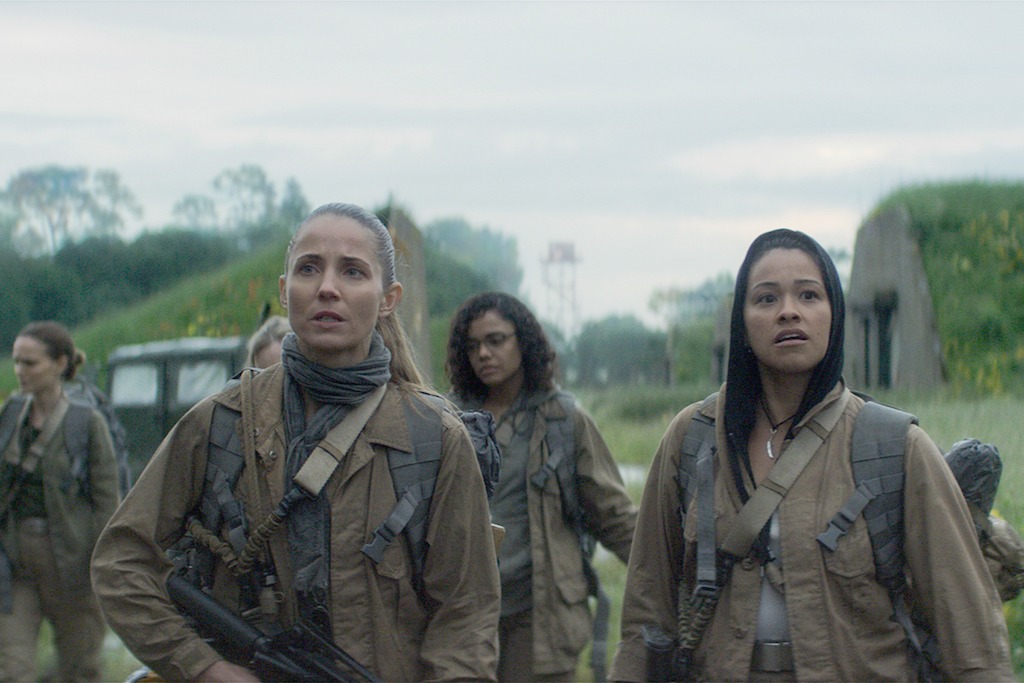The New ‘Tomb Raider’ Movie Doesn’t Care About Your Boner
Apparently Alicia Vikander’s cup size has something to do with her ability to believably raid tombs.

Oh look, a new female-fronted action movie has debuted in cinemas and men are crying about their boners. Again. Weird, how that keeps happening.
If you thought we could go almost a full year without straight men complaining that a female action star’s boobs are too small then time to reset the clock, my friends. Just nine months after bros complained that Gal Gadot’s breasts weren’t big enough for her to be Wonder Woman, they’re up in arms because apparently Alicia Vikander’s cup size has something to do with her ability to believably raid tombs in 2018’s Tomb Raider reboot.
They’re not being sexist, though, you hysterical women: the argument is simply this Tomb Raider doesn’t come close to Angelina Jolie’s Tomb Raider.
Although it would be easy to just palm this off as another example of the world being a dumpster fire and men being terrible, their anger is somewhat understandable. The first Tomb Raider movies were made for them: everything was filmed with the male gaze in mind. From the shots through Lara Croft’s hot-pant clad legs to the fact it only takes six minutes before Jolie is both wet and naked in the first movie, this was their boner fodder made real.
The new Tomb Raider, however, doesn’t give a flying fuck whether you have a stiffy or not. In fact, it wants to punch you in the stiffy… hard.
Do I have to be the asshole who says her tits are too small for me to see her as Lara Croft? Do I have to be that guy? Do I have to be the one who fucking says it?
I guess I do. Sorry. pic.twitter.com/5CsXwYFjBb
— Amazing Atheist Guy (@amazingatheist) March 10, 2018
A Lara Croft For Men
For any adaptation to work — book to movie or video game to television series — things need to be changed and adjusted to fit the medium.
And for 2001, Lara Croft: Tomb Raider fit the medium of movies pretty well. At this point, there had been seven different Lara Croft games where her breast size, hot pants and thigh holsters were as essential as her ability to solve archeological riddles. Majority of the players were men — to begin with — and from a studio standpoint, they reasoned most of the movie’s viewers would be men as well, given the character’s sexualised history.
The film reflects that. There is only one speaking female role in first film and that belongs to Lara, not so much acted by Angelina Jolie as it is reliant on her ability to wear sunglasses at night. She may have won an Oscar two years earlier for Girl, Interrupted, but Lara Croft: Tomb Raider required little more of her than to pout, arch one perfectly manicured eyebrow and wear a lot of leather so she could slo-mo strut into rooms.
Despite random flashes in London or Some Jungle, majority of the film looks as fake as the soundstage it was shot on. The visual effects don’t hold up (the ceramic soldiers, yeesh) and neither does the time-bending illuminati plot (mind you, it didn’t back then either). Directed by Simon West who made his debut with Con Air only a few years prior, it was so peak 2000s that you could have imposed Sandstorm by Darude over any action sequence and it would have fit. With a budget of $115M and a worldwide gross of just over $274M, it did okay: not great, not a huge hit, just okay.
Critics didn’t really like the movie, but they did all agree on one thing: Jolie was totally bangable in the central role. “There is more tension in Jolie’s T-shirts than in the dramatic action,” said Kirk Honeycutt (not a Bond villain) from The Hollywood Reporter.
Or there’s Stephen Hunter’s ‘critique’ from The Washington Post, which spends an entire two paragraphs talking about her lips. We don’t recommend you read the full thing on less than two glasses of wine, but here’s an extract: “As for Jolie’s presence, it’s mainly about her lips … I have concluded that her lips appear even bigger than they were one or two movies ago. Once they were puffy comfort pillows to make all the boys hate the thin-lipped gals they married and therefore ruin marriages in the thousands … Those lips, those ey – . . . oh hell, those lips.”
In summary: the reviews were horrendously sexist and majority (over 180) were from men, while only three could be found from female critics.
A Lara Croft For More Men
Two years and countless Kleenex boxes later, a sequel arrived with a title that sounded like a bunch of unconnected words randomly thrown at a whiteboard, Lara Croft Tomb Raider: The Cradle Of Life.
It came from Speed and Twister director Jan de Bont and strayed farther from the video game origins, with the studio deciding it wanted to be less Indiana Jones and more James Bond (from MI6 appearing with a mission from the Queen to the first line out of Lara’s mouth being “hello boys, you’re all wet”). Riding a dirt bike along the Great Wall Of China isn’t even the most ridiculous moment: that’s reserved for when she punches a shark in the mouth and then rides it to the surface in the opening action sequence.

Somehow this managed to be better received than the original, yet the reviews remained downright gross. “Maybe I’m over her … but Jolie is often very plain here, and her costumes are hardly ever flattering to her beauty,” read Felix Vasquez’s piece from Cinema Crazed.
It didn’t make a lot of money, with a budget of $95M — cheaper than the first — and Jolie’s star power not enough to see it creep past $160M globally. In fact, it did so bad the film was attributed with sinking the new Lara Croft video game. Planned sequels were shelved, games went quiet for a few years, and the time when all we required of a female action star was slo-mo acrobatics faded into oblivion.
Yet with the 2013 video game reboot, Lara Croft began to gain traction again. A tie-in comic series spawned and rumours of a film version of this origins tale began circulating, one that — like the game — would be grittier, grounded and aggressively appeal to the lucrative female fan base. Even before the 2018 Tomb Raider dropped, you could see the difference aesthetically in the posters. The 2001 Lara Croft: Tomb Raider one sheet is the video game covers brought to life, complete with arched back and whipping ponytail.
The poster for the sequel is all about framing her vagina, with strategic strapping creating a triangle target in her skintight, wet leotard. The 2018 Tomb Raider promo image, however, is cropped: no full body shots, no cleavage, no short shorts; just Vikander’s ripped arms and her determined face smeared with dirt.

A Lara Croft For Them
If you were old enough to remember seeing the first Tomb Raider movies in the cinema, the theatres were packed with dudes. Every time there was a particularly sexy shot the audience would break out in whoops and cheers: it was almost like community catcalling.
This time around, things were different. Opening night sessions were packed with groups of women, all coming together and celebrating the film like it was lady action movie Christmas. It wasn’t quite the same atmosphere as Wonder Woman: Lara Croft, while beloved, can’t compete with that iconic 75-year old history. There weren’t blue-haired biddies excited about finally getting to see the Amazonian warrior princess on the big screen for the first time: these women were younger. They remembered Lara Croft as one of the few female video games leads they got to play, being older themselves when the franchise was rebooted with the 2013 version.
These women grew up with Lara Croft in the same way a generation grew up with Lynda Carter. And this was the first time the Lara Croft they’ve seen on screen has been made for them as opposed to for men.
Some people have been complaining that Lara’s boobs look too small in the new Tomb Raider Movie.
Don’t worry, I got you fam. pic.twitter.com/1o4So7LuxB
— DΞΔTH!NK (@deathink) March 12, 2018
Like Jolie, this Lara Croft is played by a fellow Oscar-winner in Vikander. Unlike Jolie, this Lara Croft is framed as the physical weapon she is by director Roar (Roar!) Uthaug. She karate chop runs better than Tom Cruise and fights for her life with conviction. She is a physically and intellectually capable young woman who uses her wits, cunning and survival skills to pick off the enemy one-by-one.
While female viewers and queer women celebrated this portrayal, for some critics the lack of objectification was to the film’s detriment. “Vikander’s appearance is also markedly different than Jolie’s,” wrote Maida from the Philly Voice. “She never comes across as having an ounce of sex appeal and, at times, looks like she could be sixteen. Toss in the lack of curves and Warner Brothers could have decided to gender bend and make a film titled Luke Croft and it would have come across much the same way.” His entire paragraph was later pulled from the review with an editor’s note.
An actual exert from a professional #TombRaider review….. pic.twitter.com/aX57sbxEpf
— Chris Wilson (@CrisMovieCorner) March 15, 2018
Vikander trained seven months for the role, undergoing a strict regime of weights, cardio and MMA so she would be convincing. Put simply, she got jacked. Unlike the two earlier films, there’s no wish fulfilment afforded to male audience members — Croft has no pseudo-romances with interchangeable dudes played by Daniel Craig or Gerard Butler. There’s no love story here, just action, occasional archaeological exploration, and a story that moves with a feverish energy.
The guys who grew up thinking of Lara Croft as their sexual fantasy had 20-odd years of that version. Now it’s time for the rest of us — the women, men and queers who want to see an action heroine as impactful as the John McClanes, the Indiana Jones’ and the Ethan Hunts of the cinematic world.
So just let us have it, will ya?
—
Tomb Raider is in cinemas now.
—
Maria Lewis is a journalist, screenwriter and author of It Came From The Deep and the Who’s Afraid? novel series, available worldwide.
